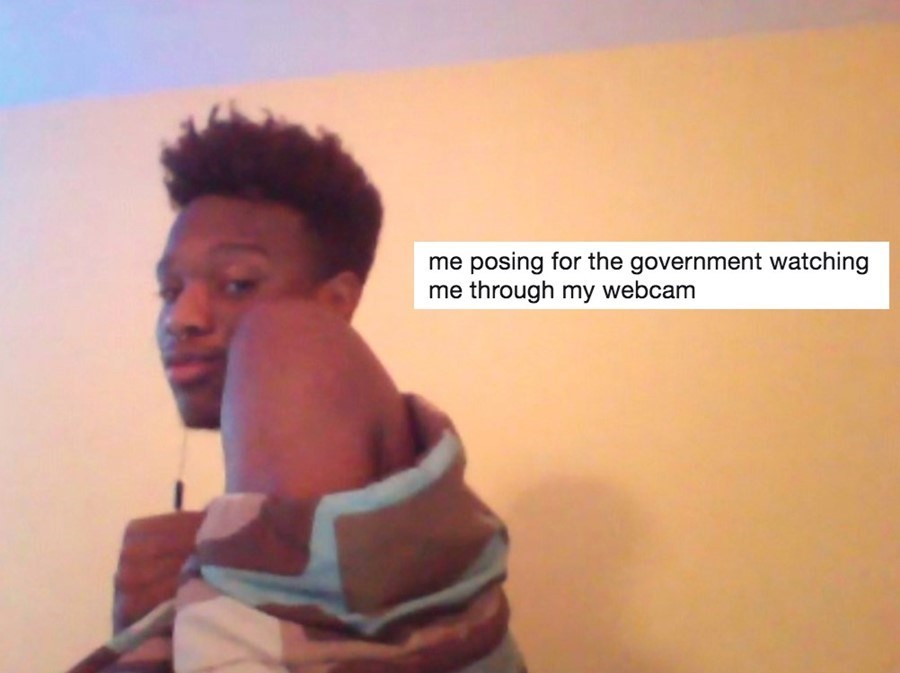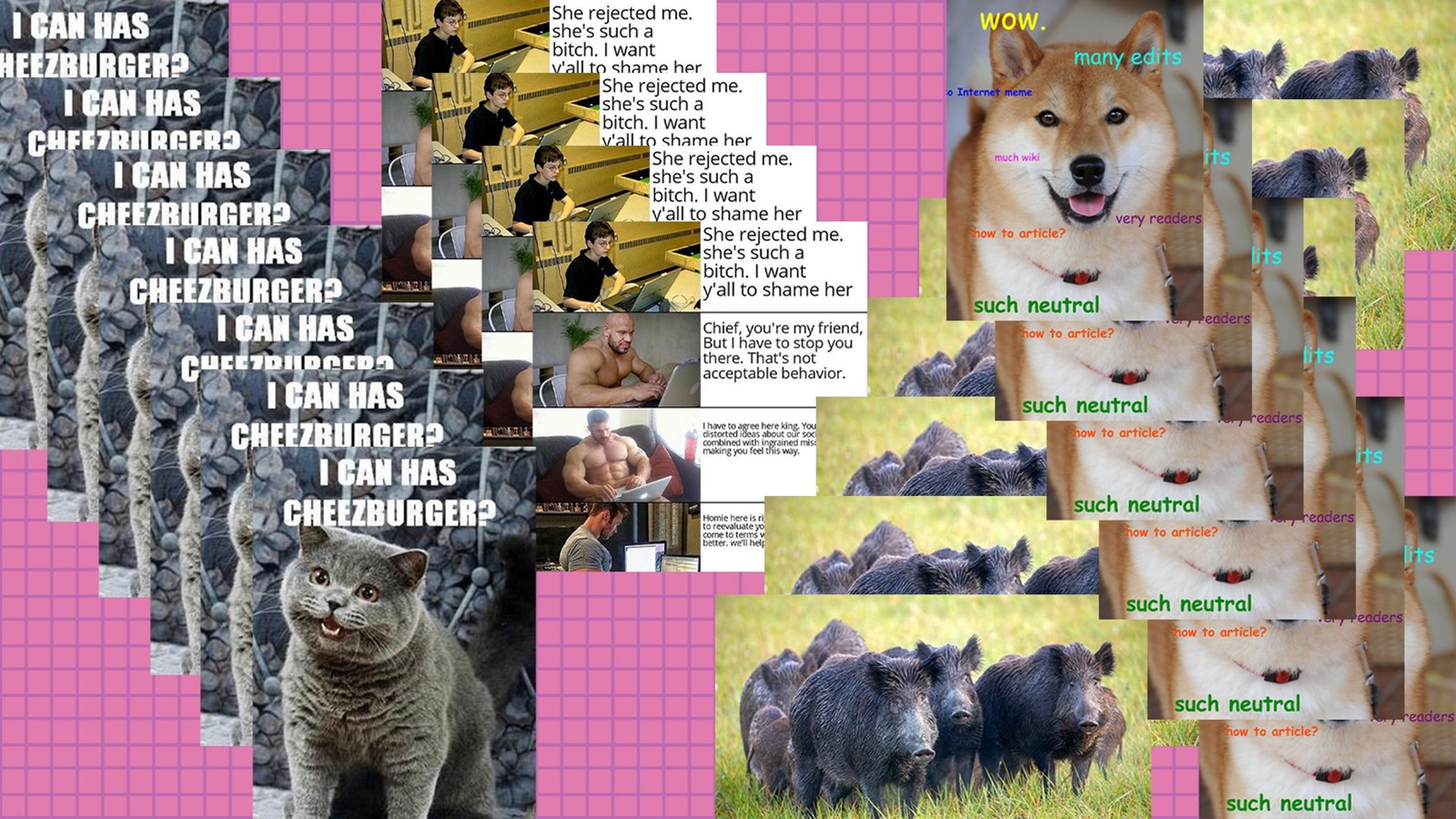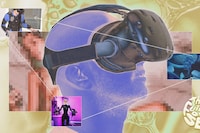From VSCO girls to doggos, moths and galaxy brains, the defining memes of the 2010s spoke for us when we couldn’t
Deep fakes, influencers, viral fashion – we live in a world unrecognisable from the one we stood in ten years ago. As a chaotic decade comes to a close, we're speaking to the people who helped shape the last ten years and analysing the cultural shifts that have defined them. Explore the decade on our interactive timeline here, or head here to check out all our features.
It’s nearly 2020, and the things we found funny ten years ago no longer feel relevant. In the 2010s, memes were democratised, transcending nerdy messageboards and the depths of 4Chan to become part of mainstream humour, cutting through political discourse from Hong Kong to Washington DC, spliced into our IRL conversations, and used as emotional reference points when we didn’t have words otherwise.
The times have changed: Nyan Cat, catz haz-ing cheezburgerz, Scumbag Steve, and Women Laughing Alone With Salad don’t cut it anymore. These days, you’re just as likely to see a meme about a Dyson Airblade hand dryer, with the caption, “My father died in a tragic Dyson Airblade accident” as you are a ‘Jeffery Epstein didn’t kill himself’ meme, or something about 30-50 feral hogs.
In this giant race to the bottom of irony, memes have become mirrors to our discordant times (and timelines), where banality, inanity, and calamity jumble together. The result is a hodgepodge of codified cultural references, politics, and inane imagery, which reflect the moods and emotions of the illegible world we live in. Would the 2001 version of you recognise the cultural significance or humour in our go-to memes of 2019? The falsely reported suicide of an American financier and convicted pedophile isn’t the first thing that comes to mind when you think ‘lol’, and neither is one rural American’s defence of his assault rifle against the 30-50 feral swine he claims frequent his back yard.

What’s funny, however, is the framing and context of memes, which – because of the relentless, global pace of the digital world – have wider creative license to travel than they would IRL. “Information that isn’t initially funny is spliced up and recontextualised so that it becomes funny. We see this with pop culture and political stuff, topics that don’t initially seem funny but take on a new hilarity when dropped into bizarre contexts,” explains Philip Seargaent, author of The Emoji Revolution. “A lot of humour is based on people’s shared culture and values, their shared knowledge of the world, which the comic then plays with or subverts.”
These techniques, Seargeant argues, have always been a part of comedy, but the internet allows us to present these ideas in quickfire ways. “This is why we’re seeing so much self-referential comedy,” he says, “as people are splicing together seemingly incongruous things – often visuals, pop culture references, or topics in the news – and generating humour directly from their incongruity.” Check the “I feel personally attacked by this relatable content” Facebook meme group, with 104K members, or the comments of any marginally popular meme-curating Instagram account to see it play out: “it me”, “@becky this is us!”, “I feel very seen rn”.
It’s through this medium that memes have ordered and aestheticised the chaos around us, shaping our relationship to an increasingly troubling social and political landscape, characterised by a swing towards conservatism, the triumph of white fear, and impending environmental disaster. “I think humour and introspection are two conditions we naturally flock to. My memes combine the two, making room for a lot of relatability and connection,” explains Instagram account sighswoon – a user that curates reflective, aesthetic memes mostly on self-care, the at times farcical nature contemporary wellness, the emotions of the extremely online generation. “Making these memes is therapy for me, because putting a complex or troubling thought in a light, humorous meme format feels cathartic. By sharing it online, I give others the opportunity to feel that release too.”
“Memes have ordered and aestheticised the chaos around us, shaping our relationship to an increasingly troubling social and political landscape”
Remember the FBI agent meme? It popped up on Twitter last year, following the fight against the UK’s ‘Snooper’s Charter’, which gave the government mass digital surveillance powers – as in, reading your texts, accessing your online browsing history, and all that fun stuff. There’s thousands of memes online, imagining a personally assigned FBI agent individually monitoring us through our webcams, watching us binge Netflix shows, take endless chains of selfies. It’s hilarious and absurd, but it’s not far off either. Whether it’s via weather apps or local news apps, our data is tracked at every possible moment through our mobile phones; ads are tailored to our online tastes using spooky algorithms; and Elon Musk is literally developing mind-reading software as we speak.
In this sense, we’ve seen memes become more of an expression of our shared experience: our fears, desires, and deepest thoughts, all of which get fed through our hive mind, the internet. Yet it’s not just online that memes thrive, but IRL too. Tragic or disturbing events are forever being co-opted by the memescape, and filtered back into reality, through the lens of humour. A prime example of this is Harambe, a gorilla who became an overnight mainstream cult hero after he was shot at Cincinnati Zoo in 2016. Adopting a strange new existence, entirely divorced from the reality of the gorilla, Harambe escalated from an online meme sensation (photoshopped pictures of Harambe with celebrities, on election ballot papers) to a real-life candlelit vigil held in his name, halfway across the world, in Leeds.

But there’s more subtle ways that memes infiltrate our offline lives. Meme linguistics have taken over our daily lexicon, with old Vines (RIP) quoted in real life: “two shots of vodka”, “damn Daniel”, the “good boi” have all been prevalent in our everyday language during particular fads. I regularly find myself misusing grammar to imitate the broken language of Doge culture, using modifiers like “wow”, “amaze”, and “excite” in awkward placings for my own amusement.
Anastasia Denisova, a Lecturer in Journalism at CAMRI, University of Westminster and specialist in internet memes and society, says the grammatical quips and intentional misspellings across the memescape is just the evolution of human expression. Think of it as a kind of virtual body language: “It’s the acceleration, not infantilism, which brings the constant shortening of words and names, to speed things up,” she says. Seargeant agrees: he describes the role of memes as adding “emotional colour” to the digital world. “It’s not replacing traditional language, but being used either alongside it, or to enhance what we’re expressing in words alone,” he says. “A lot of this can still very much be seen as part of the continuing evolution of human connection.”
Sure, doggos are good bois, and longerinos do fast zoomies, but should we be at all concerned with the backpedaling to what can feel like toddler drivel? Like Doge, the language we use online often feels infantile, as if we’re trying to emotionally regress when we can. You can see this across our digital landscape, from memes like ‘I’m baby’ and ‘smol bean’ to the humour that performs on TikTok, where the most popular users thrive on slapstick (think Laurel and Hardy vibes) skits, silly pranks, and viral challenges like ‘Juice, Sauce, Little Bit of Dressing’ and ‘Eat on the Beat’.
“Tragic or disturbing events are forever being co-opted by the memescape, and filtered back into reality, through the lens of humour”
Perhaps it’s a way to cope and make sense of the farcical world around us – a smol jolt of dopamine to remedy the crushing anxiety that comes with living in austerity Britain, a homophobic country, Trump’s America. A place where half your monthly salary goes toward your rent, a world threatened by climate doom. It’s no wonder we’re turning to cutesy images of Kirby, or slapstick gags to give us cheap thrills, and if purposefully mispronouncing words, or telling ourselves ‘I’m baby’ helps soften the blow of everyday existence, then who are we to question it?
A cornerstone in this has to be 2019’s (bizarre) self-care template memes: “Hey! I’m so glad you reached out. I’m actually at capacity / helping someone else who’s in crisis / dealing with some personal stuff right now, and I don’t think I can hold appropriate space for you. Could we connect [later/date] or time instead/ Do you have someone else to reach out to?” On paper, these scripted responses are meant to help manage close friendships and boundaries, but, in placing them in the context of a meme, they become ways to process our ever-changing cultural mores. Up until the last ten years, emotional discourse in this capacity didn’t exist in the mainstream, let alone in humour.
Seargent reiterates: “Humour today reacts to debates about social justice and free speech, and is often in the front line when it comes to debates about what it's appropriate to say, and what's offensive. This is very noticeably the case as debates around identity politics, 'political correctness', and other freedom-of-expression issues have become such a central part of the public conversation, especially on social media.”
Put aside the shapeshifting social norms and changing zeitgeists, however, and you’ll find that today’s humour is no different to what it was a decade ago. “That kind of imagery, it’s been in the newspapers for years,” says Richard Clay, professor of digital culture at Newcastle University. “Structurally, humour isn’t that different from the 18th century.” He points to the work of late British political satirist, James Gillray, whose single-sheet caricatures were based on the political events of the era, in much the same way as memes are. “You won’t get the jokes because you don’t get the eighteenth century culture, but at the time, they were hilarious and really, really dangerous, really political, really controversial, and really provocative. But these jokes aren’t that different (to now), they’re basically belittling the socially important and doing it in a way that’s surprising and slightly uncomfortable.”

So, what’s actually changed? At its most basic, there’s been an increase in the speed and number of people a joke travels to, and a large part of this is because of social media. The speed and reach of the internet has meant that we’ve now adapted our humour to fit into our fast-paced online world: content is bundled into 140-character quips, seconds-long video snippers, or single images. “Twitter and other social networks constrain the amount of space we can use to express ourselves,” explains Denisova. “This forces us to make jokes faster, sharper, shorter. We also live in the time of social acceleration – when we can buy things, order a meal and communicate 24/7, we also accelerate our humour.”
Memes now occupy the same role as an inside joke among friends, only on a global stage. This not only means that there’s an infinite number of people ‘in’ on the joke (or meme), but there’s more people playing into it, which means a higher chance of it abstracting and being pushed to its extremes – the proliferation of the ‘Galaxy Brain’ meme. “Fundamentally, it’s that everyone now has access to the means of production, dissemination and reception to a joke,” explains Clay. “It’s not just about telling a joke in the pub, it’s not just a face-to-face joke, it’s not just reading a joke in the newspaper, you can actually come up with a joke and share it globally with the click of a switch.”
Many of us can’t remember a world without the internet, and memes, as an extension of this, have captured our zeitgeist in ways no other method could. They were political and cultural disruptors, but also above all, a prism for a vexed generation, and a collective defence mechanism against the age of terror that has come to define the 2010s. When we laughed, we laughed together, and it was through memes that we found pathos. Looking at some of the earliest viral videos (“it’s a double rainbow!”) it’s hard not to be taken away by their comedic earnestness, and as the socio-political landscape worsens, sometimes it feels like there’s nothing we won’t joke about online, but simultaneously, our want and need for the comforting nostalgia of the meme world has only ballooned.

